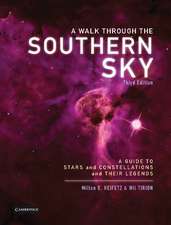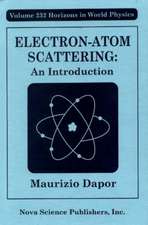Theory of Slow Atomic Collisions: Springer Series in Chemical Physics, cartea 30
Autor E. E. Nikitin, S. y. Umanskiien Limba Engleză Paperback – 22 dec 2011
Din seria Springer Series in Chemical Physics
- 20%
 Preț: 585.30 lei
Preț: 585.30 lei - 15%
 Preț: 643.00 lei
Preț: 643.00 lei - 15%
 Preț: 635.96 lei
Preț: 635.96 lei - 18%
 Preț: 953.03 lei
Preț: 953.03 lei - 15%
 Preț: 644.63 lei
Preț: 644.63 lei - 15%
 Preț: 638.43 lei
Preț: 638.43 lei - 15%
 Preț: 649.22 lei
Preț: 649.22 lei - 15%
 Preț: 647.40 lei
Preț: 647.40 lei - 15%
 Preț: 638.89 lei
Preț: 638.89 lei - 15%
 Preț: 652.31 lei
Preț: 652.31 lei - 15%
 Preț: 638.43 lei
Preț: 638.43 lei - 15%
 Preț: 637.13 lei
Preț: 637.13 lei - 18%
 Preț: 952.57 lei
Preț: 952.57 lei - 18%
 Preț: 947.85 lei
Preț: 947.85 lei - 15%
 Preț: 636.45 lei
Preț: 636.45 lei - 15%
 Preț: 649.87 lei
Preț: 649.87 lei - 18%
 Preț: 953.65 lei
Preț: 953.65 lei - 18%
 Preț: 894.03 lei
Preț: 894.03 lei - 15%
 Preț: 647.27 lei
Preț: 647.27 lei - 18%
 Preț: 1249.00 lei
Preț: 1249.00 lei - 15%
 Preț: 646.30 lei
Preț: 646.30 lei - 18%
 Preț: 954.14 lei
Preț: 954.14 lei - 24%
 Preț: 1226.82 lei
Preț: 1226.82 lei - 18%
 Preț: 961.72 lei
Preț: 961.72 lei - 18%
 Preț: 1002.31 lei
Preț: 1002.31 lei - 24%
 Preț: 647.25 lei
Preț: 647.25 lei - 18%
 Preț: 888.49 lei
Preț: 888.49 lei - 18%
 Preț: 908.04 lei
Preț: 908.04 lei - 15%
 Preț: 641.38 lei
Preț: 641.38 lei - 15%
 Preț: 585.40 lei
Preț: 585.40 lei - 15%
 Preț: 639.90 lei
Preț: 639.90 lei - 18%
 Preț: 897.02 lei
Preț: 897.02 lei
Preț: 647.92 lei
Preț vechi: 762.26 lei
-15% Nou
Puncte Express: 972
Preț estimativ în valută:
124.02€ • 134.76$ • 104.24£
124.02€ • 134.76$ • 104.24£
Carte tipărită la comandă
Livrare economică 21 aprilie-05 mai
Preluare comenzi: 021 569.72.76
Specificații
ISBN-13: 9783642820472
ISBN-10: 3642820476
Pagini: 452
Ilustrații: XII, 434 p.
Dimensiuni: 155 x 235 x 24 mm
Greutate: 0.63 kg
Ediția:Softcover reprint of the original 1st ed. 1984
Editura: Springer Berlin, Heidelberg
Colecția Springer
Seria Springer Series in Chemical Physics
Locul publicării:Berlin, Heidelberg, Germany
ISBN-10: 3642820476
Pagini: 452
Ilustrații: XII, 434 p.
Dimensiuni: 155 x 235 x 24 mm
Greutate: 0.63 kg
Ediția:Softcover reprint of the original 1st ed. 1984
Editura: Springer Berlin, Heidelberg
Colecția Springer
Seria Springer Series in Chemical Physics
Locul publicării:Berlin, Heidelberg, Germany
Public țintă
ResearchCuprins
1. Introduction.- 2. General Formulation of Scattering Problem Under Quasi-Classical Conditions.- 2.1 Scattering Amplitudes and Cross Sections.- 2.2 Scattering Equations.- 2.3 Collisions of Two Many-Electron Atoms.- 2.4 Integral Cross Sections for Isotropic Collisions.- 3. Diatomic Electronic States.- 3.1 Quantum Numbers and Wave Functions of a Free Atom..- 3.2 Quantum Numbers and Wave Functions of Diatoms.- 3.3 Adiabatic States, Diabatic States, and Correlation Diagrams.- 3.4 Coupling Between Electronic States. Selection Rules.- 4. Approximate Calculation of the Electronic States of Diatoms.- 4.1 Atomic Potential and Atomic Orbitals.- 4.2 Diatomic Interactions at Large Distances and the Heitler-London Approximation.- 4.3 Pseudopotential Method for Interatomic Interactions.- 4.4 Short-Range Atomic Interactions.- 4.5 Coupling Between Electronic States.- 5. Elastic Scattering.- 5.1 Quasi-Classical Scattering Amplitude.- 5.2 Quasi-Classical Scattering Matrix.- 5.3 Classical Scattering.- 5.4 Integral Cross Sections.- 5.5 Differential Cross Sections.- 6. Approximate Calculation of a Multichannel Quasi-Classical Scattering Matrix.- 6.1 Common-Trajectory Approach.- 6.2 Matching Approach.- 6.3 Perturbation Approach.- 7. Two-State Scattering Problem.- 7.1 The Two-State Model. Adiabatic and Diabatic Representations.- 7.2 Construction of the Two-State Quasi-Classical S Matrix by the Matching Method.- 7.3 Two-State Semiclassical Models.- 7.4 Differential Cross Sections and Deflection Functions.- 8. The Linear Two-State Landau-Zener Model.- 8.1 Formulation of the Model.- 8.2 Nonadiabatic Transitions Far from the Turning Point. Landau-Zener-Stueckelberg Solution.- 8.3 Nonadiabatic Transitions Near the Turning Point.- 8.4 Validity of Linear Model and of Analytical Expressions for Transition Probabilities.- 8.5 Cross Sections for the Linear Model.- 9. Nonlinear Two-State Models of Nonadiabatic Coupling.- 9.1 Exponential Model.- 9.2 Linear-Exponential Model.- 9.3 Other Nonlinear Models.- 10. Multistate Models of Nonadiabatic Coupling.- 10.1 Transitions Between Degenerate States.- 10.2 Transitions Between Highly Excited States.- 10.3 Generalizations of the Linear Model.- 11. Case Study — Intramultiplet Mixing and Depolarization of Alkalis in Collisions with Noble Gases.- 11.1 Formulation of the M* — X Scattering Problem.- 11.2 The Scattering Matrix.- 11.3 Transition Probabilities and Cross Sections for Isotropic Collisions.- A. Quantum Theory of Angular Momentum.- A. l Rotation Matrices and Spherical Functions.- A.2 Coupling of Angular Momenta, Clebsch-Gordan.- A.3 Matrix Elements of the Irreducible Tensor.- Operators.- References.














